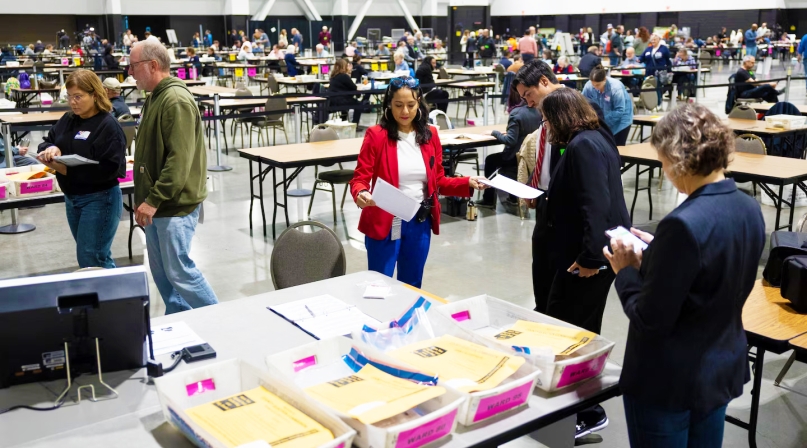Counties overcome challenges on Election Day

In the aftermath of Election Day, county election offices across the country are taking note of the challenges they faced, including bomb threats, technical issues and ballot printing problems that led to extending voting hours and recounting ballots or duplicating them to be properly scanned.
Bomb threats
At least 25 counties received Election Day bomb threats at polling places and ballot-counting locations, the majority of which were in the swing states of Arizona, Georgia, Michigan Pennsylvania and Wisconsin. Polling sites in Georgia received the largest number of threats, with Fulton County alone receiving 32 bomb threats, delivered through a variety of means including emails and calls to 911, according to Fulton County Police Chief W. Wade Yates.
The threats originated from Russian email domains and none of them were deemed credible, according to the FBI. Some polling locations were evacuated, resulting in directing some voters to cast their votes at nearby polling locations and extending voting hours.
“To those who interfere in our elections, I have a very direct message for you: Citizens will not be fearful of coming out to vote,” Georgia Sec. of State Brad Raffensperger said in a Nov. 5 press conference. “In spite of having over 60 bomb threats, people still voted. We will not be cowered, you will not sow discord and strife. It did not work.”
Ten counties in Arizona — two-thirds of the state’s total counties — received bomb threats. Gila County, Ariz. received a bomb threat to its elections office, not a polling location, so it did not impact the voting process in the county, according to Gila County Elections director Eric Mariscal.
Mariscal, who has worked in the elections office for 16 years, said it was the first bomb threat, to his knowledge, that the county had received related to an election, but that the county’s emergency management division had worked with the elections office plan for bomb threats.
“The Gila County emergency management division, they are the ones that set the protocol for when we have a bomb threat or anything like that,” Mariscal said. “They have a template that they put into place to how we react to it and respond to it, so they take care of all that and provide that information to us and we just go ahead and follow the template and take the appropriate actions.”
Ballot printing issue in Pennsylvania
In Pennsylvania, considered the biggest battleground state in the country for this presidential election, Cambria County saw a ballot printing issue that stymied voting tabulators. They were unable to read the ballot markings at all 128 of the county’s polling locations.
The ballot problem initially led to long lines and voter confusion and several voters left their polling locations without casting a ballot, solicitor Ronald N. Repak said in an emergency petition election officials filed to the Cambria Court of Common Pleas to extend voting hours. The county had voters continue to cast their vote by paper ballot while the issue was being assessed and, per a court order, voting was extended two hours county-wide on Election Day.
Cambria County initially intended to hand count the ballots, but through consultation with the Department of State and Election Systems & Software, the county elections office was advised that when similar problems arose in past elections, it was faster to duplicate the ballots and run the new copies through scanners for tabulation than to hand count the original ballots, so that’s what they did, Repak said. There was still a delay in calculating the votes due to the issue, but it would have been much longer if the ballots had been hand counted, he said.
Cambria County’s elections office reached out to the local Democratic and Republican chairwomen to ask for volunteers to help with duplicating the ballots, which also helped speed the process along, Repak said. The county initially expected to have around 35,000 ballots to be hand counted or duplicated, but ended up with roughly 65,000 ballots.
“I want to praise the commissioners,” Repak said. “They have directed us to get as much information to the press or any association out, and I think it really was a great decision to make this as transparent as possible, and it wouldn’t have been possible if Cambria County basically said, ‘We can fix this on our own.’
“Reaching out to the commissioners, reaching out to the Department of State and the state party and local parties has really helped with the entire process.”
Tests were conducted prior to Election Day, but the mistake wasn’t discovered until voting started, according to Repak. Moving forward, the county will make changes to how it prepares for future elections, he noted.
“There will be changes made, but we’re not even at that point right now,” Repak said Nov. 8 (the county finished counting Election Day ballots on Nov. 11). “Our sole focus is to get the ballots counted, and the next step will be to gather the facts and dot the i’s, cross the t’s, to make sure that this never happens again.”
Retabulating ballots in Milwaukee, Wis.
In Milwaukee, Wis., roughly 31,000 absentee ballots had to be recounted because the 13 tabulators at the Baird Center, the central count center, were not properly locked and sealed before tabulation. The issue in Milwaukee, the largest city in Wisconsin, resulted in a delay in reporting the state’s broader election results.
Per Wisconsin state law, early voting absentee ballots can’t be counted until Election Day. Milwaukee Mayor Cavelier Johnson told WISN-TV that he plans to renew efforts to pass a bill that would allow the processing of absentee ballots to begin prior to Election Day, in the wake of the tabulator issue.
Ann Jacobs, chair of the Wisconsin Elections Commission, released a statement on X, formerly known as Twitter, announcing that the ballots would be recounted, despite the fact there was a bipartisan consensus that the tabulators had not been tampered with.
“Both political parties agree that nothing was wrong with the tabulation, so far. However, in the interest of transparency and so that people can have confidence in the tabulation, the decision was made to re-tabulate the ballots run through so far.”
The city of Milwaukee brought in firefighters, health workers and IT staff to assist elections staff with the recount.
Election was safe and secure, officials say
Despite bomb threats and routine malfunctions with voting equipment and ballots, the election was safe and secure, according to officials.
“With the exception of some of these extraordinary moments, such as the bomb threats … we have seen by and large normal things that we know happen,” Virginia Kase Solomón, the president and CEO of Common Cause, a non-partisan organization that works to prevent voter suppression, told The Guardian.
“Unfortunately, these are still things that happen in our election system, despite the fact that we have had so many gains when it comes to early voting and vote by mail, among other things.”
Related News

Multi-State Information Sharing and Analysis Center (MS-ISAC) loses federal funding
On March 11, the Cybersecurity and Infrastructure Security Agency (CISA) announced a $10 million cut in funding for the Multi-State Information Sharing and Analysis Center (MS-ISAC), which provides critical local assistance for cybersecurity threat detection and analysis resources and support.
Election administrators anticipate continued challenges
The 2024 election was success in the eyes of elections administrators, but several panelists see areas of concern brewing for future years.

County Countdown – Nov. 4, 2024
This week's County Countdown features interviews from this year’s NACo Annual Conference.
County News
DHS: Gearing up for elections security

